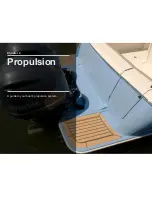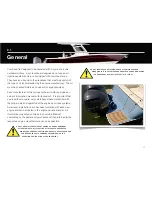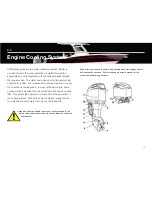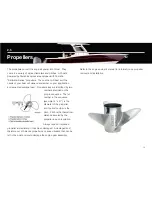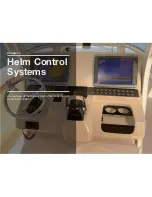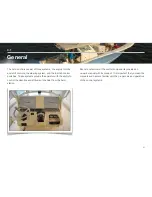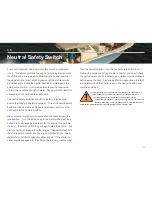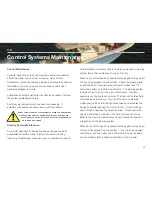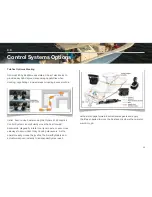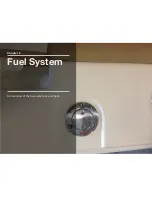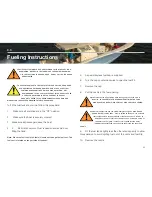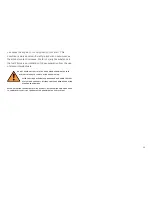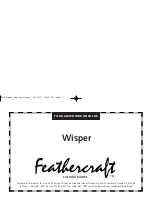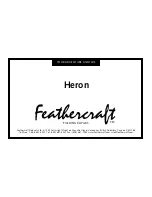
All outboard engines have a tilt and trim feature. Most outboard
engines have tilt/trim switches built into the engine shift and
throttle controls that allow the operator to control the position of
the outboards from the helm. Typically, a switch or switches on
the port control lever grip activates the tilt/trim for the engines.
Some engine controls have two switches on the control cover to
activate each engine individually.
Moving the outboard
closer to the boat
transom is called
trimming “in” or
“down.” Moving the
outboard further
away from the boat
transom is called
trimming “out” or
“up.” In most cases,
the boat will run best
with the outboard
adjusted so the hull will run at a 3 to 5 degree angle to the water.
The term “trim” generally refers to the adjustment of the
outboard within the first 20o range of travel. This is the range
used while operating your boat on plane. The term “tilt” is
generally used when referring to adjusting the outboard further
up for shallow water operation or trailering. For information on
the proper use and maintenance of the power tilt and trim, please
refer to the engine owner’s manual.
The engine hoses and cables or the transom gel coat can be damaged by
tilting the engines to the full up position with the engines turned to the
wrong position. Most boats require the steering wheel to be turned
completely to starboard before tilting the engines to the full up position.
You should monitor EACH engine as it tilts to determine best full tilt
engine position for your boat.
Some autopilots have engine position sensors that are mounted to the hydraulic
steering cylinder. With these autopilots, the engine position sensor bracket
could hit the transom when the engineS ARE tilted to the full up position
and cause damage to the engine rigging, the autopilot or the transom. If
you have an autopilot installed on your boat, you should monitor the
location of the engine cables and autopilot brackets as the engines are
tilted to determine the best engine position and maximum engine tilt for your application.
3.4
Engine Power Tilt and Trim
24
Summary of Contents for 320 LXF
Page 1: ...320 LXF Scout Boats OWNER MANUAL ...
Page 2: ...Chapter 1 Owner s Information Warranty Certification and Boat Information ...
Page 11: ...Chapter 2 Propulsion A guide to your boat s propulsion system ...
Page 32: ...Chapter 4 Fuel System An overview of the fuel system of your boat ...
Page 40: ...Chapter 5 Electrical System An overview of the electrical system of your boat ...
Page 54: ...Chapter 6 Fresh Water System An overview of the fresh water system of your boat ...
Page 59: ...Chapter 7 Raw Water System An overview of the raw water system of your boat ...
Page 65: ...Chapter 8 Drainage System An overview of the drainage system of your boat ...
Page 70: ...Chapter 9 Ventilation System An overview of the ventilation system of your boat ...
Page 73: ...Chapter 10 Exterior Equipment An overview of the exterior equipment on your boat ...
Page 83: ...Chapter 11 Interior Equipment An overview of the interior equipment on your boat ...
Page 88: ...Chapter 12 Safety Equipment An overview of the safety equipment on your boat ...
Page 99: ...Chapter 13 Operation A general guide to operating your boat ...
Page 124: ...Chapter 14 Routine Maintenance A guide to keeping your boat running in good condition ...
Page 147: ...Chapter 16 Appendix Reference documents logs and schematics for your boat ...
Page 154: ...153 ...
Page 155: ...154 ...
Page 156: ...155 ...
Page 157: ...156 ...
Page 159: ...158 ...
Page 160: ...159 ...
Page 162: ...161 ...

